Hidizs S8 Pro Robin Portable DAC Review
This review matters for me a lot because it’s my first one of a kind: the very first review of a sound source that I would never have intended to write if it hadn’t been for Hidizs, which suddenly offered me to test their portable DAC.
The simple truth is that I often looked at articles about all kinds of sources, and every time it seemed to me that, firstly, some crap was written there, and, secondly, it should be written… the other way. One needs to write more clearly, to give more explanations to the readership, to tell how exactly and with what settings the measurements were made. I got certain questions concerning measurements while using RMAA, and, as it turned out, it wasn’t only about me.
In a nutshell, it became clear that I need to go into it the same way I do it with headphones measurements. I need to do it myself and in a big way. Therefore, some six months ago I hit a textbook on the basic theory of electrical engineering and fell to the theory recollection because a bit too much time has passed since my second year in college. I also purchased a measuring system at that time. I measured, thought, wondered, consulted, read, ordered extra cables, measured again, thought again, etc. There are squillions of nuances in this field, but there is practically no information that is easily accessible and quickly acceptable. Therefore, I had to suss out many things by experiment. In recent months, I have been in a state of “well, that’s almost it”, there was one last push, some final questions without answers. But I lacked energy and time to draw a line and start writing.
And next moment an email came from Hidizs with a proposal for collaboration. “It’s a sign!”, I thought and made every effort to delve into the topic at least to the point of “I only know 20%, but I am sure of these 20%”.
By the way, the amount of additional hardware that was required to write this review is kind of lying beyond the bounds:
- E1DA Cosmos ADC, Scaler & APU measurement gear;
- nearly 20 various custom cables and adapters;
- load board;
- ND9B digital sound level meter calibrator;
- multimeter;
- Toppin HS01/02 USB isolators;
- VICTOR VC328B/A thermal imager;
- FNIRSI FNB58 USB tester;
- my common measuring rig for headphones;
- a toothpick!
To cut it short, today we will talk about Hidizs S8 Pro Robin Portable DAC worth of $79.
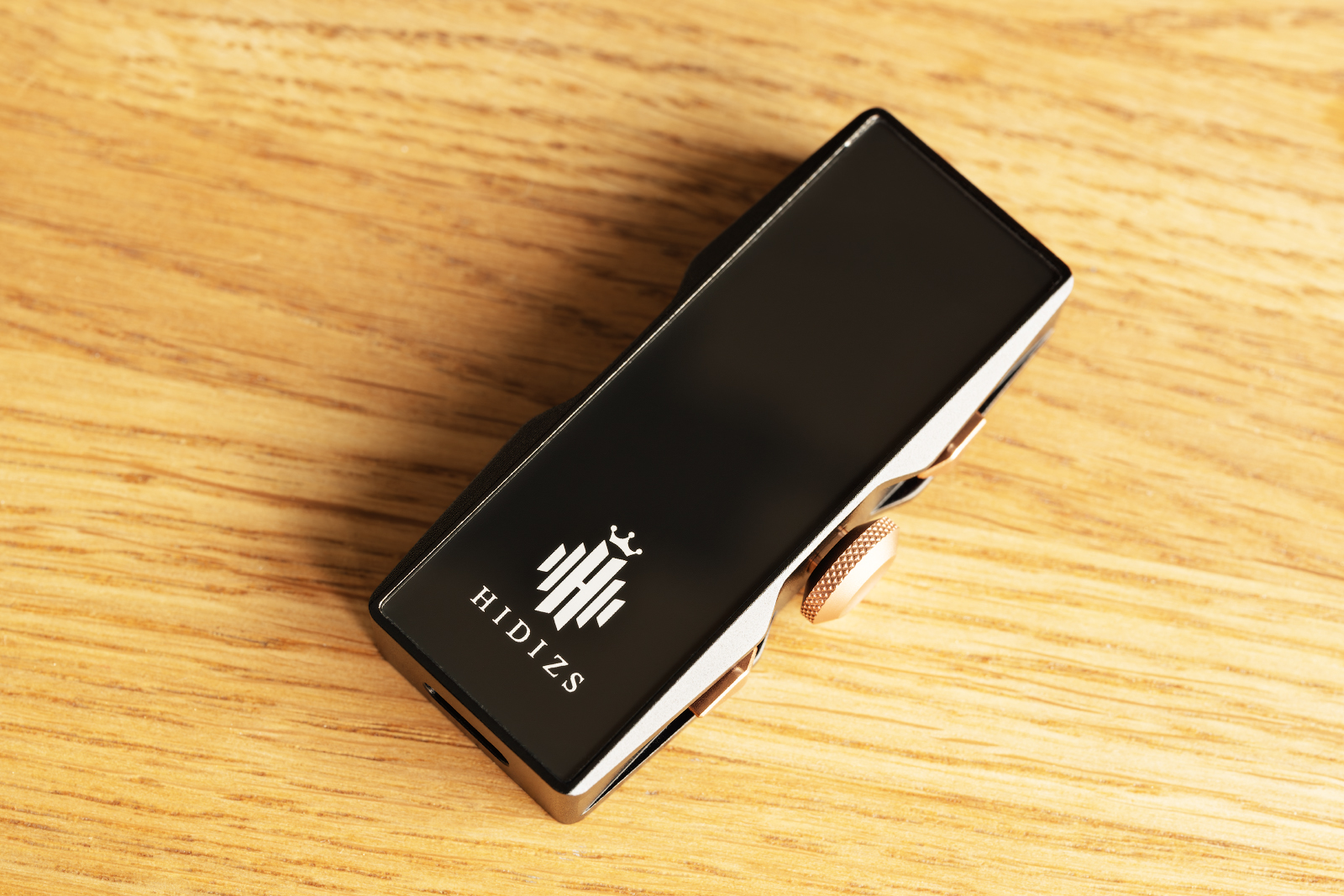
And I want to particularly thank Ivan Khlyupin, the creator of the E1DA Cosmos line of devices, and a user nicknamed Nick_l for the help with measurements – I would really go nuts and hang up my axe without them.
What’s included
S8 Pro comes in a small plastic box. Thanks, Hidizs, it’ll be convenient to store your device after it’s purchased.
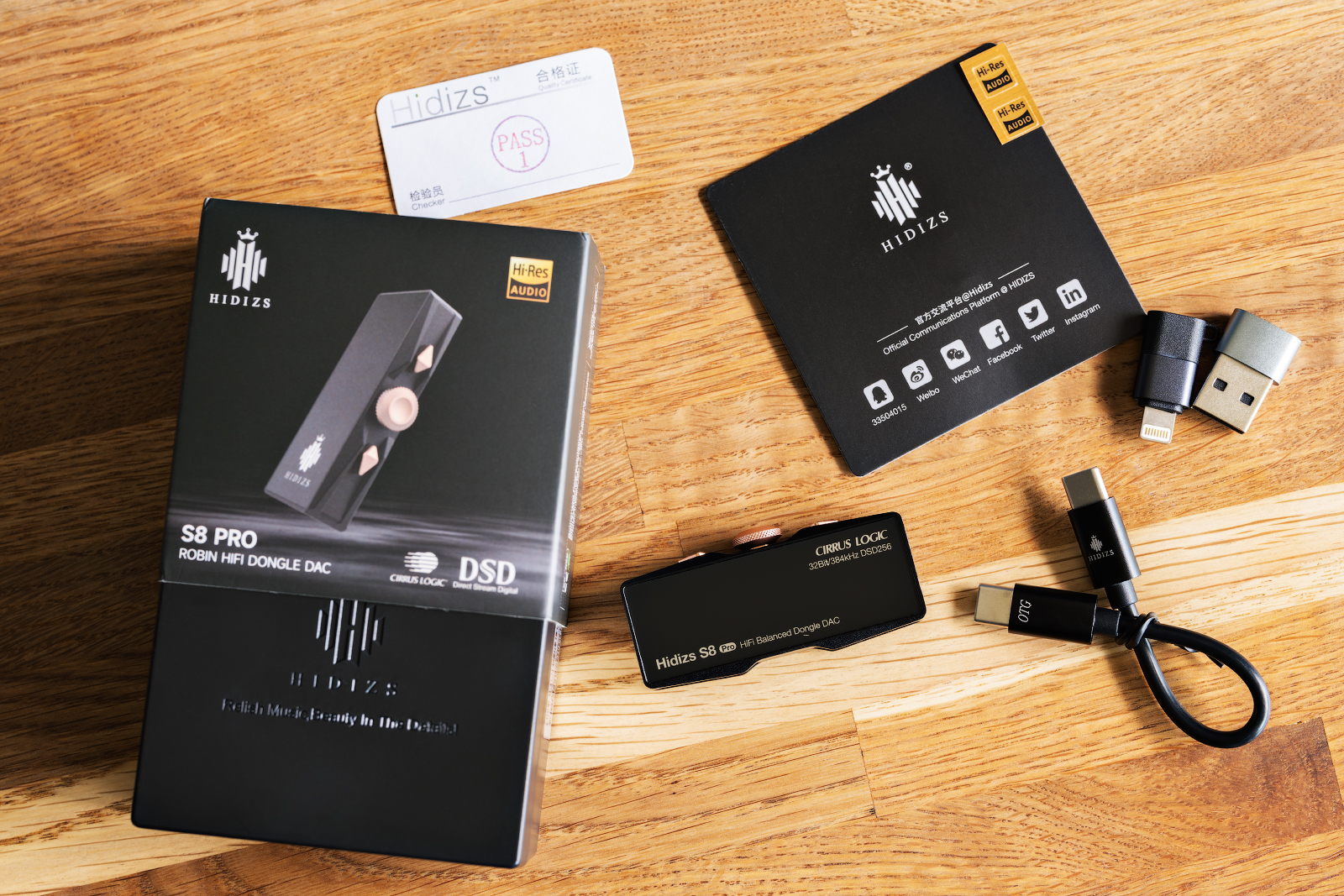
What do you get:
- the device itself;
- a Type-C to USB-A adapter;
- a Type-C – Lightning adapter;
- a short Type-C – Type-C cable;
- papers and stickers.
The set is good, the box is great (a beauty tip: I would write the model name on it, just right on plastic).
Design, assembly, technology
S8 Pro is a small rectangular block made of glass and metal. There are buttons on the top face and nothing on the bottom one — just small metal ribs.
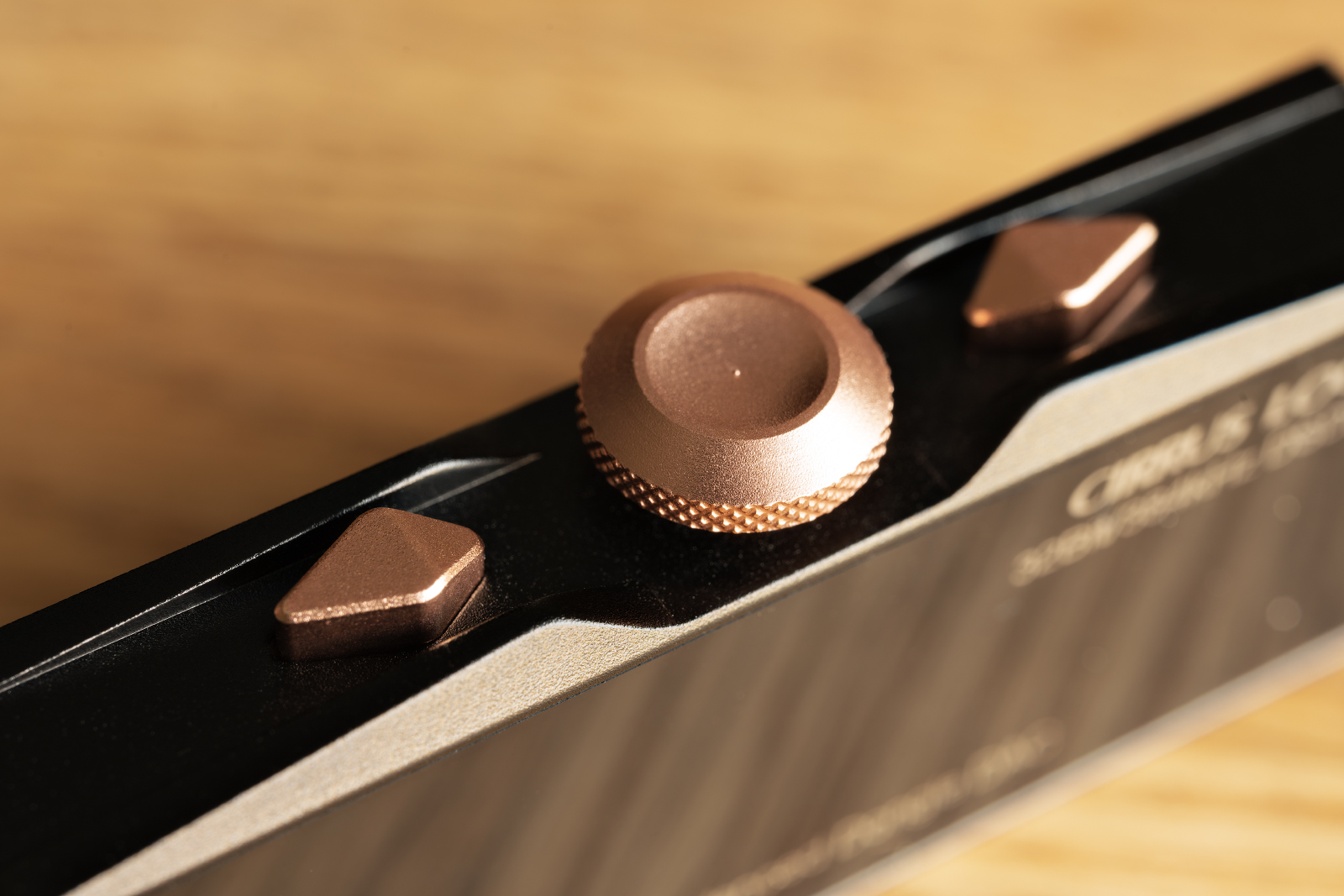
The buttons are not loose, unlike ones of DAWN Pro.
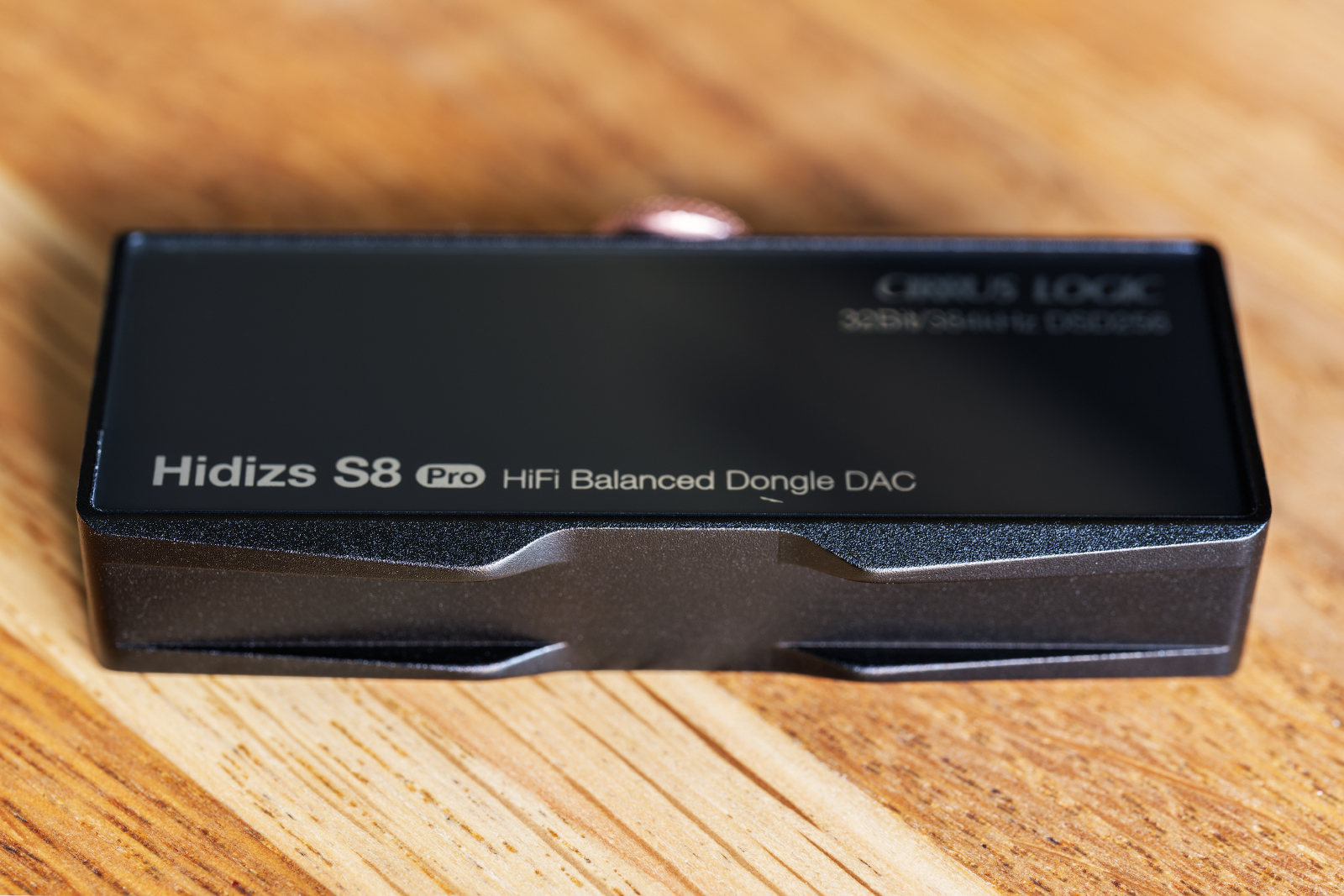
Rectangular glasses are inserted from the sides. And they’re just glasses – I asked the manufacturer about them and got a concise answer: “It’s not Gorilla Glass, it’s ordinary.” The use of glass in smartphones can somehow be justified by the need for wireless charging. But I can’t guess why it was used in a device like this. Yet it doesn’t scratch much, at least it’s something.
There is a Type–C USB input on one end and unbalanced and balanced outputs on the other one.
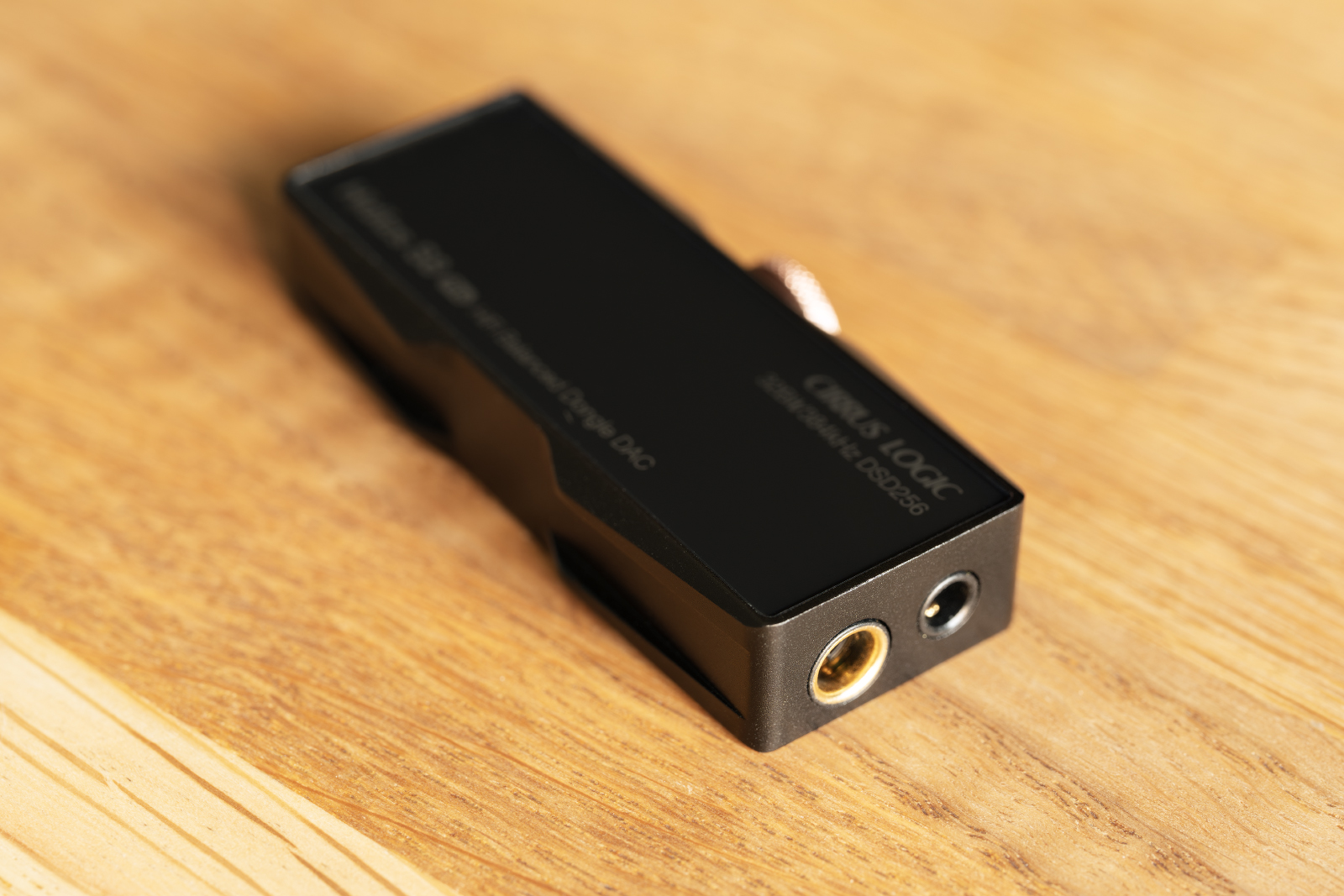
The device is assembled very well, it feels totally monolithic.
I have no complaints about the quality of manufacture and assembly, everything is perfectly done.
Ergonomics, usage experience
Hardware
Here’s a couple of words about running hot. I connected Truthear x Crinacle ZERO: RED earphones to S8 Pro via a 10-Ohm adapter to a 3.5 jack, set the volume to 75%, and let it play all kinds of music for an hour.
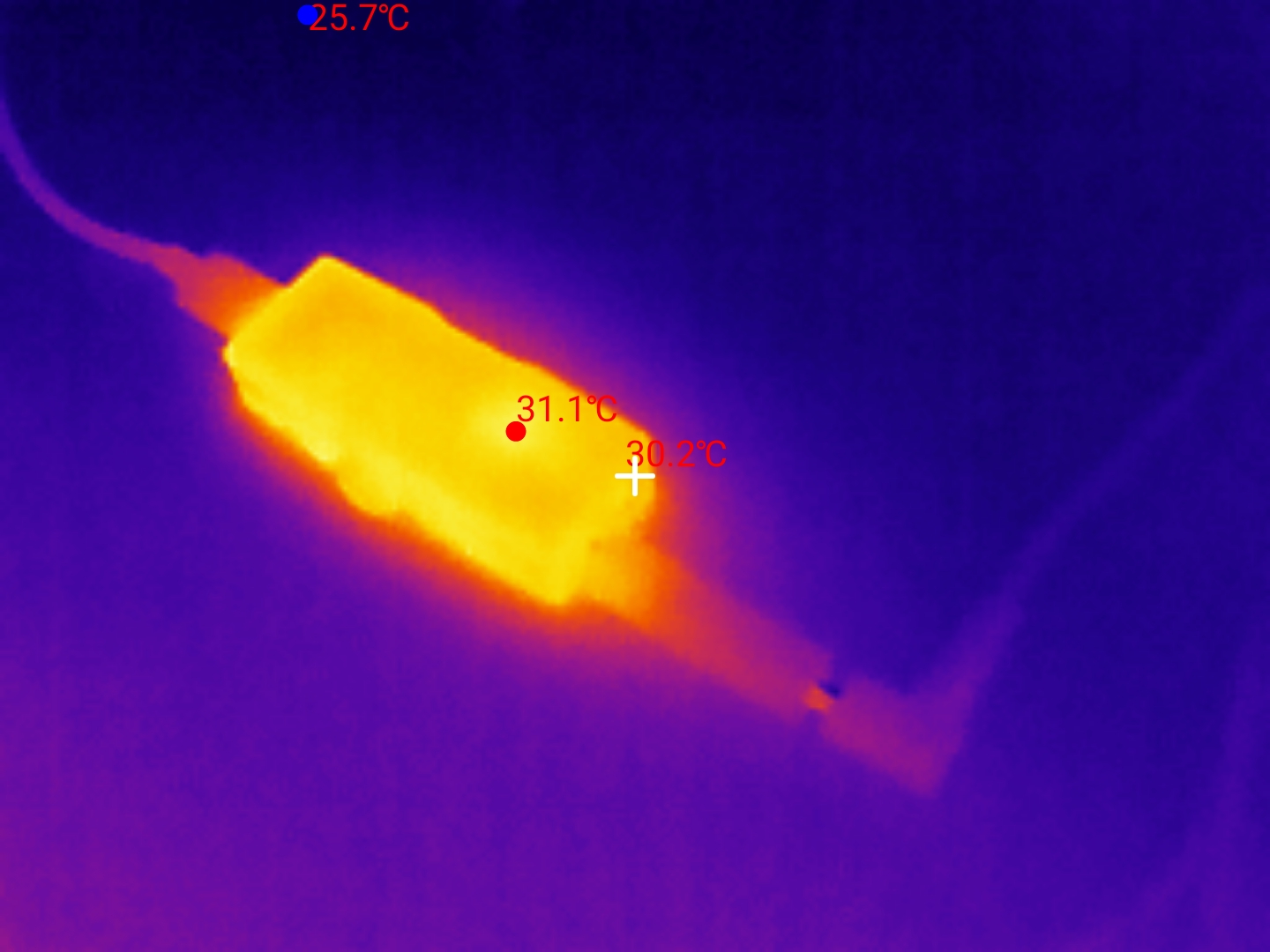
As you can see, the difference between the temperatures of the DAC and the table whereon it is equals to 6 degrees Celsius only.
Here is an identical experiment with Meze Empyrean headphones and the balanced output.
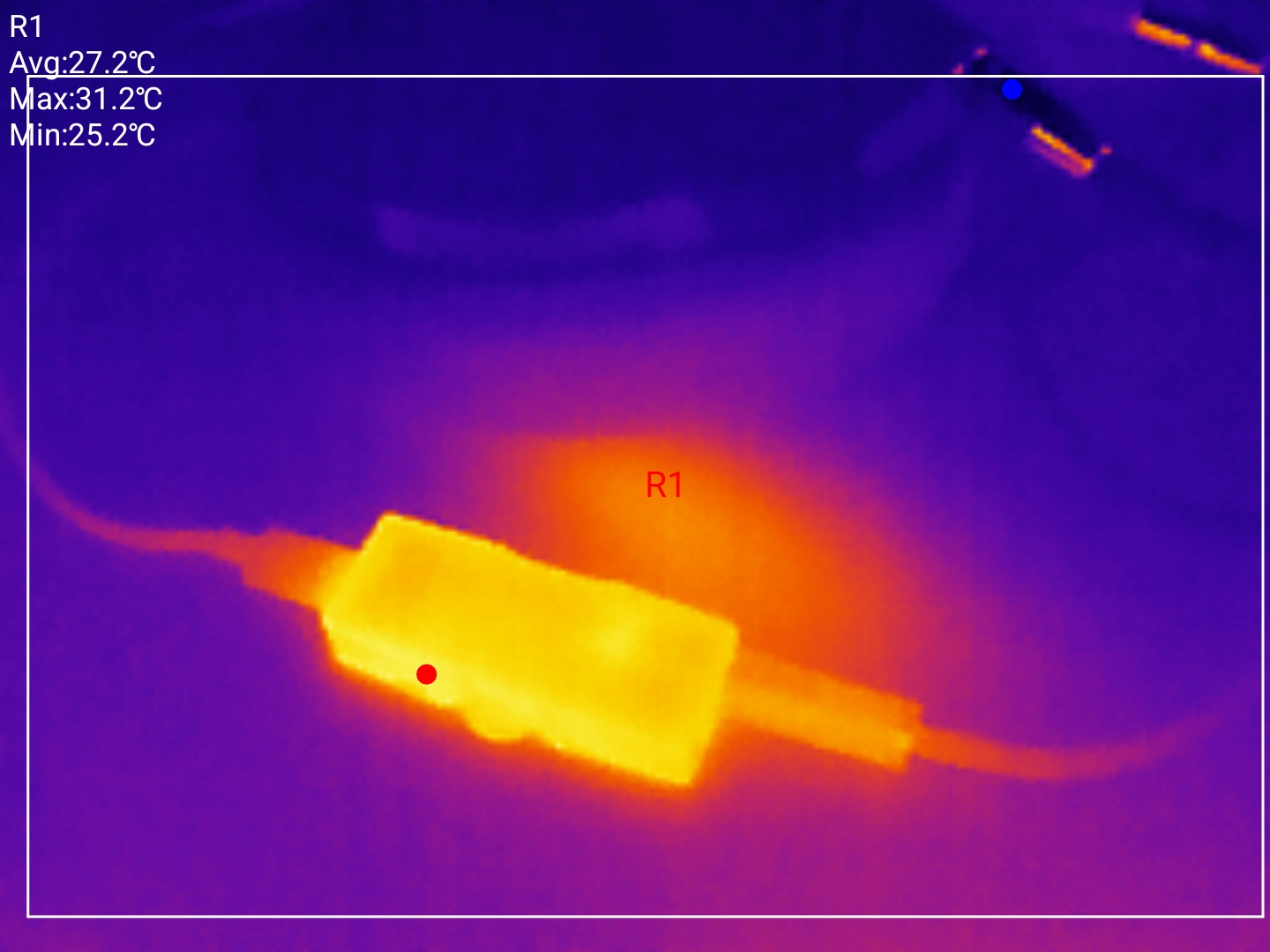
Again, the temperature difference did not exceed 6 degrees Celsius. That is, in general, S8 Pro does not run hot while in operation.
The central button can be easily located by touch with your fingers, it stands out from the case quite a bit.
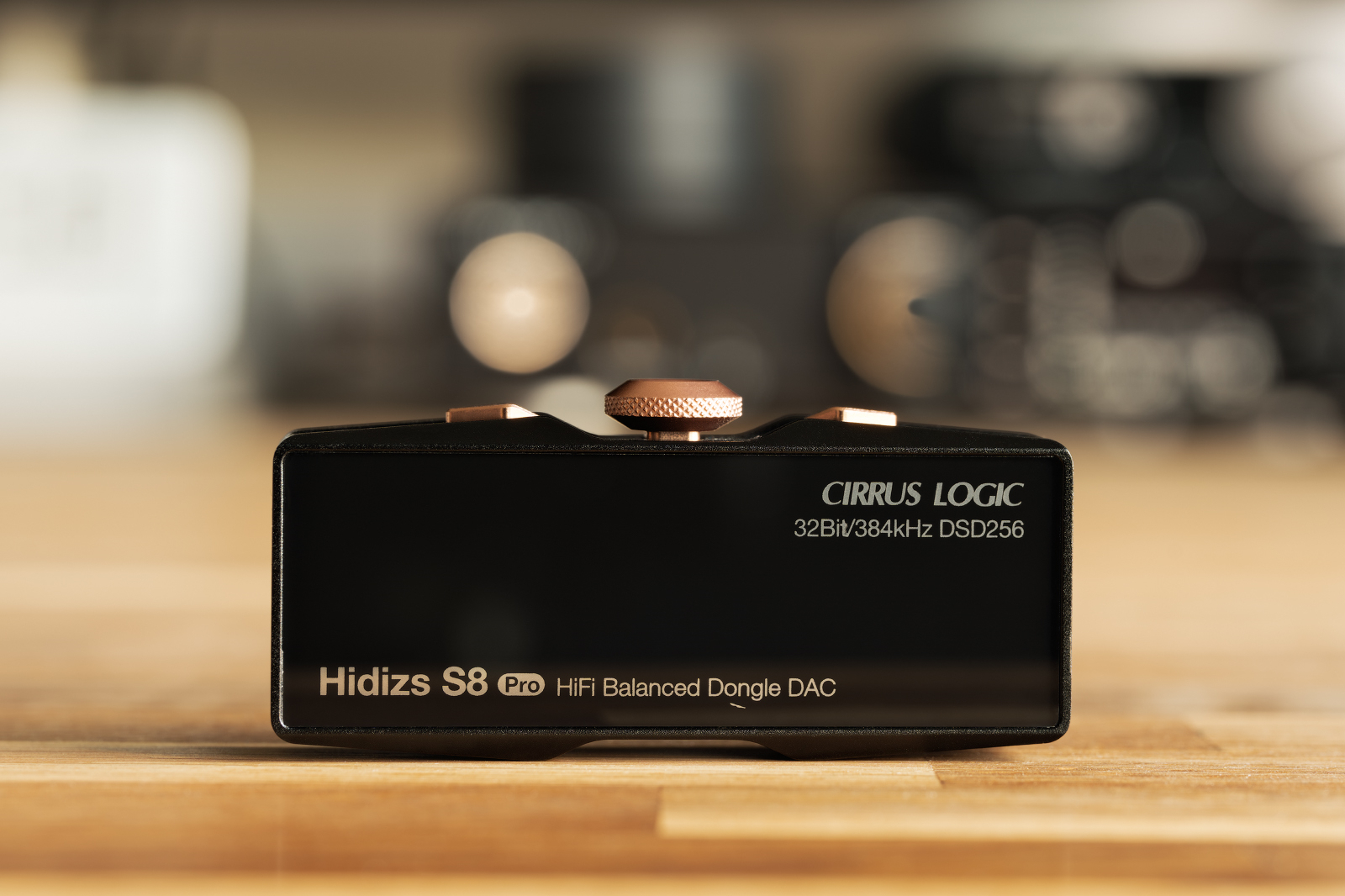
The only ergonomic blunder of the manufacturer is that it looks like a joystick or a wheel. Accordingly, it is crucial to overcome the desire to rotate it with effort or to turn it aside at the outset of using the device.
Other than that, everything is great. The buttons are pressed with a clear pleasant click, and there is no accidental pressing. Of course, the glass of the case becomes dirty immediately after S8 Pro has been taken out of the box.
I can’t tell anything good or bad about S8 Pro ergonomics — the use of the device is as comfortable or uncomfortable as all similar devices. Because… let’s say it together: “Portable DACs are NOT CONVENIENT!” It’s a separate device that dangles next to the smartphone, and it can scratch the smartphone case, or the screen, or even camera glasses. It’s not convenient to put a smartphone with a DAC in your pocket and take it out.
How can this problem be solved? In a primitive way! Make a universal case with MagSafe attachments and sell it integrally with a round magnetic sticker. Has anyone ever thought of this? As far as I know, it was only Lepic that made Mag Safe Dac Pocket. This is a Korean company, so ordering it to Russia is a fat fucking chance, and it’s not even easy to learn the very fact of existence of such a thing. Even on Reddit, not many folks know about it.
Besides, it’s possible to produce special cases at least for the most popular smartphone models. But they don’t exist either.
Everything is much better in the usage scenario, “I bought a portable DAC, connected it to an office PC, and this is how I listen to music at work”, this is a really convenient option. But we should remember that we can’t connect a headset to S8 Pro — even the sound itself will not work, let alone the microphone.
Software
When in use, the manufacturer’s logo on the case is constantly highlighted in one color or another, indicating the current sound format.
S8 Pro doesn’t have its own app for mobile operating systems. The only additional feature is to switch filters by pressing the volume buttons simultaneously. There are six filters, and the filter selected is color-indicated on the device body when switching.

Take note of the NOS filter (the second one in succession) simulating the operation of an R2R matrix.
When connected to an Android smartphone, S8 Pro immediately ‘undertakes’ the audio output, while the central button can control playback.
In Windows 11, the device is detected automatically and does not require driver installation. The ASIO driver can be downloaded from the manufacturer’s website. And the central button also allows for playback control. The hardware and software volume controls are interrelated: when the side buttons are pressed, a volume bar appears on the screen.
Quick specifications overview
- Device type: portable DAC.
- Chip: two CS43131 chips.
- Inputs: one Type-C input.
- Outputs: 3.5 mm jack (unbalanced), 4.4 mm jack (balanced).
- Supported formats: PCM up to 32 bits/384 kHz, DSD up to 256 kHz.
- Power: 80 MW per 3.5 channel at 32 Ω impedance, 160 MW per 3.5 channel at 32 Ω impedance maximum.
- Compatibility: Android, iOS, Windows, Mac OS, iPad OS, Harmony OS.
- ASIO support: manufacturer’s driver, plus (at least) ASIO4ALL and FlexASIO.
- Weight: 17 grams.
Measurements
E1DA Cosmos ADC, as well as a load board were used for measurements. The equipment was connected to the data lines via Topping HS01/HS02 isolators. An ND9B sound level meter calibrator was used to calibrate the microphone. The following settings were adjusted in the REW software (RTA module):
- Smoothing: no smoothing
- FFT Length: 1M
- Averages: Exponential 0.97
- Window: Hann
- Max Overlap: 93.75%
The audio output was made via FlexASIO drivers. I’ll describe the measuring rig in detail in another post.
In order to understand what we are measuring — the parameters of the measured or the measuring equipment — let’s look at the Cosmos ADC’s own noise without load:
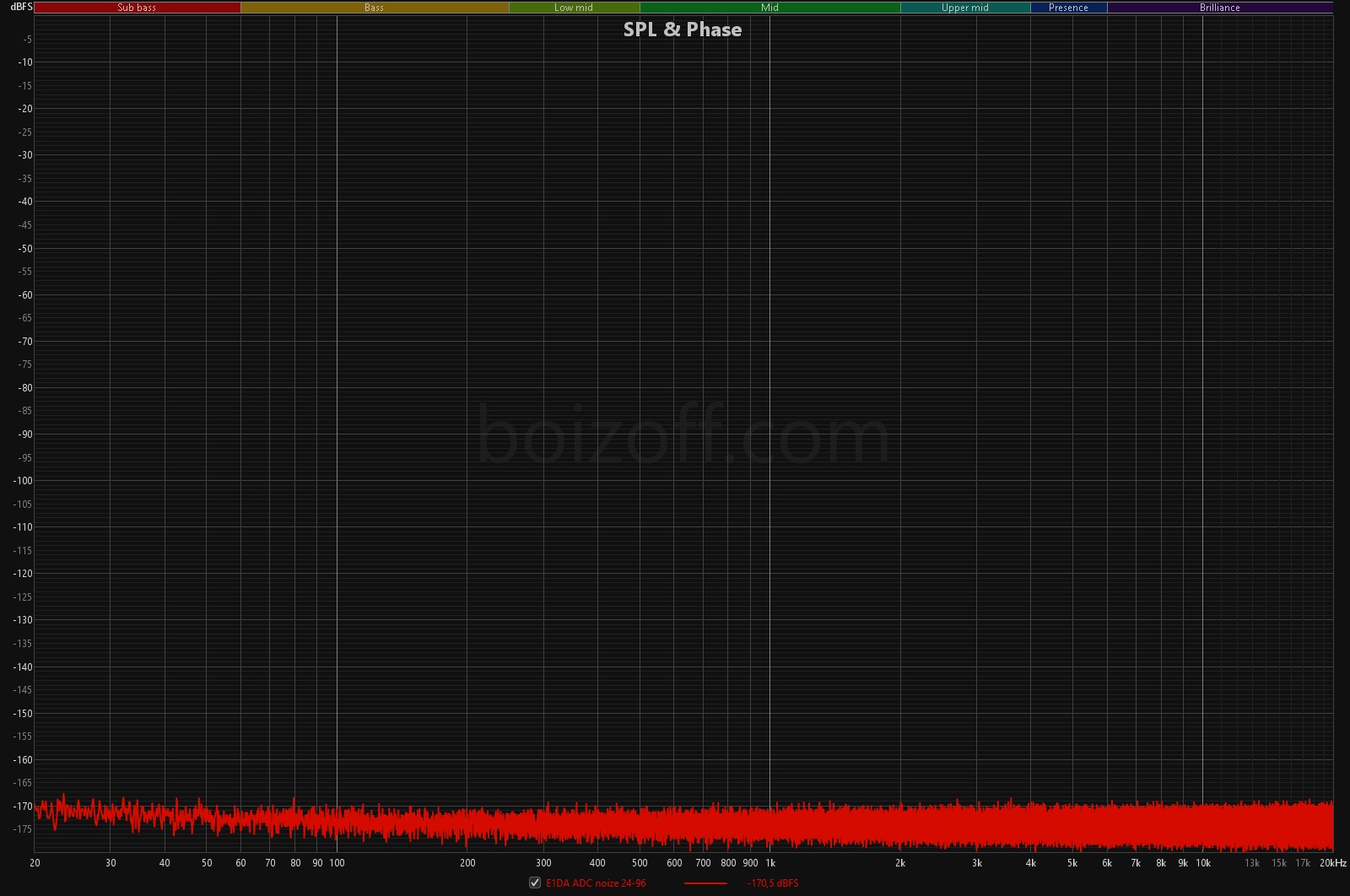
It goes below -170 dB.
S8 Pro noise without signal and load:
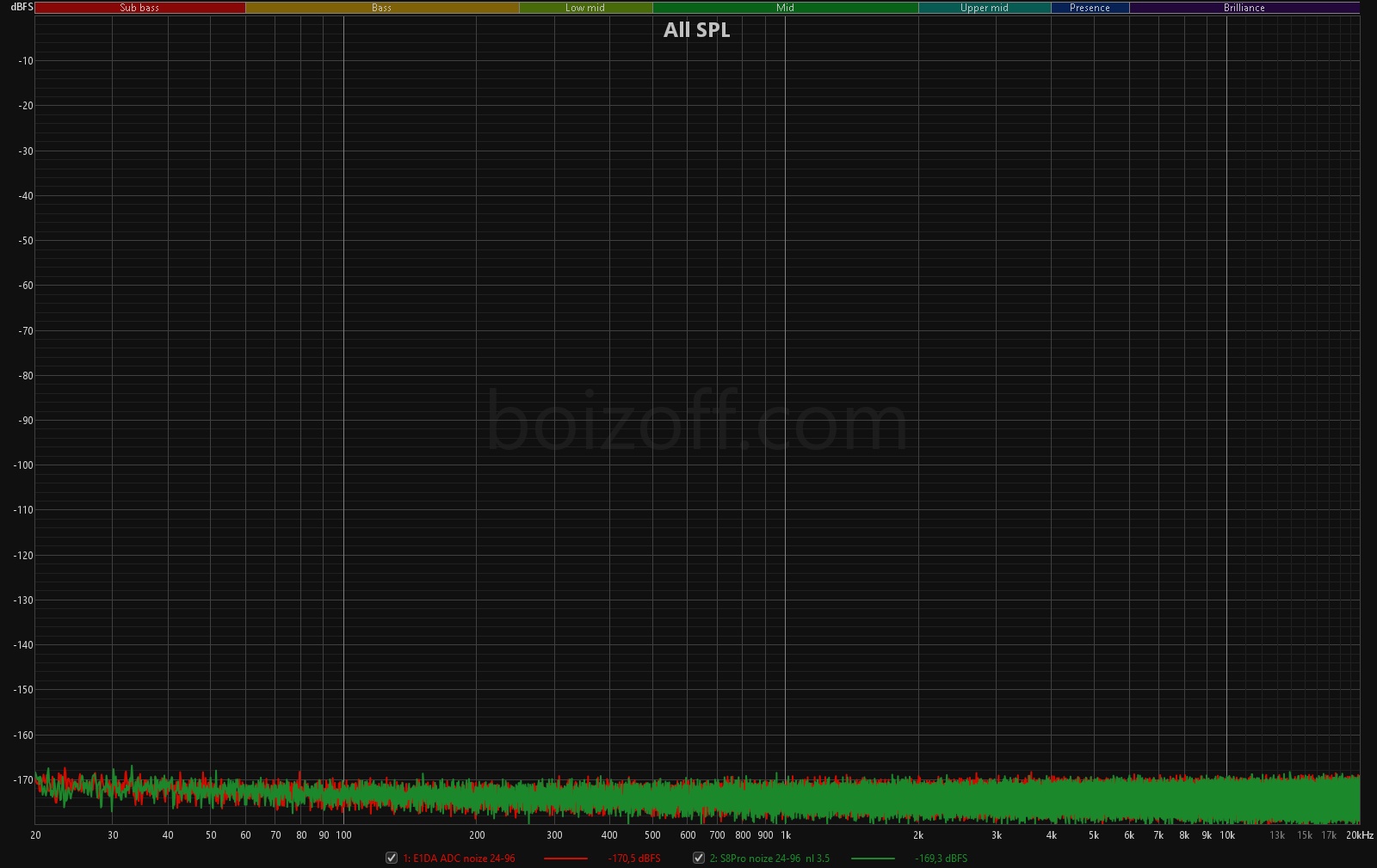
And, seeing that the levels match, there is reason to believe that the device completely breaks the circuit in the no-signal state.
Let’s see how filters affect the sound:
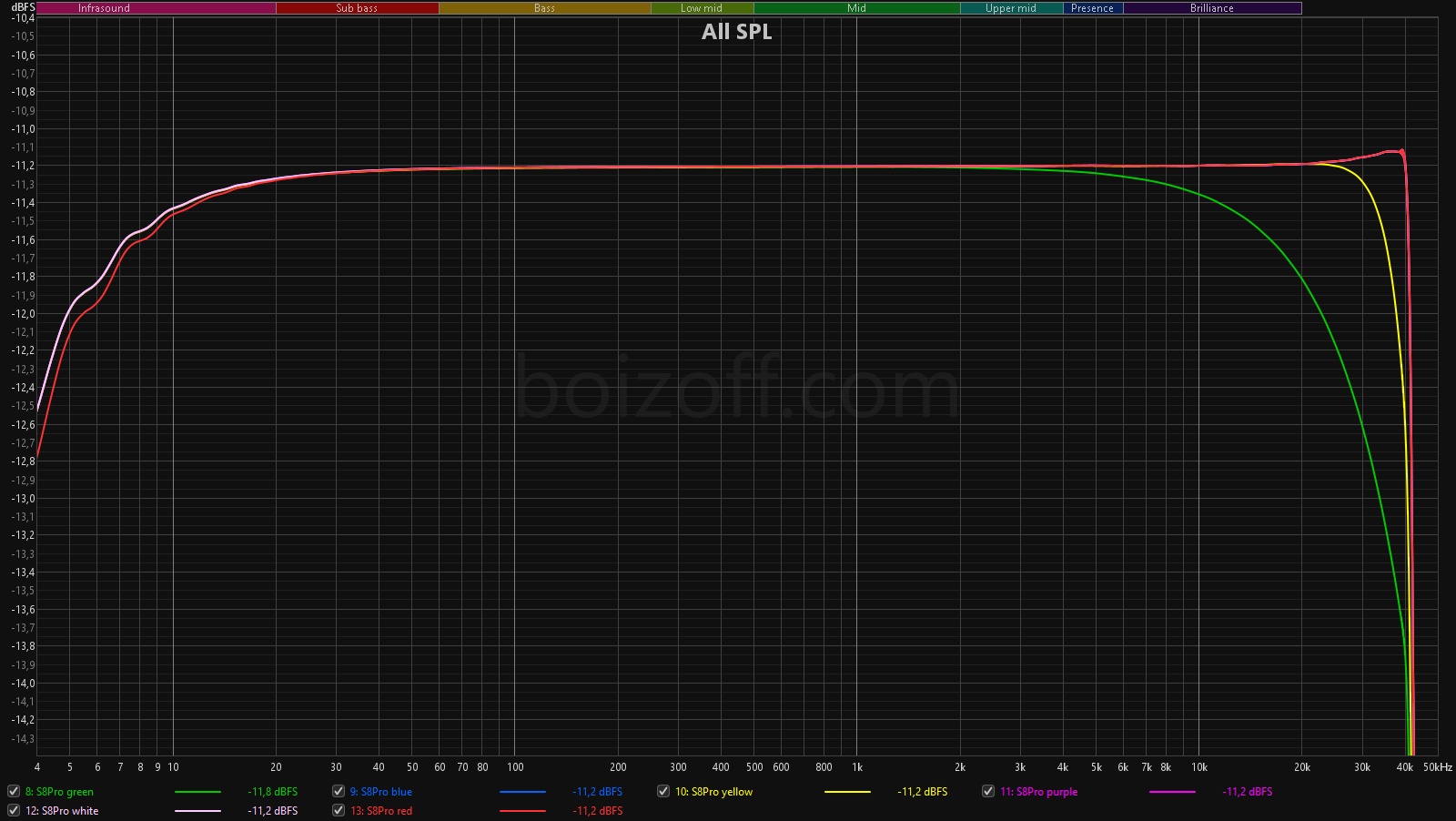
As expected, the frequency response is even in all options, and only the green curve of the NOS filter gives some insignificant drop at high frequencies.
Sine at 1 kHz (0 dBFS), 100% volume on S8 Pro, 3.5 output, no load:
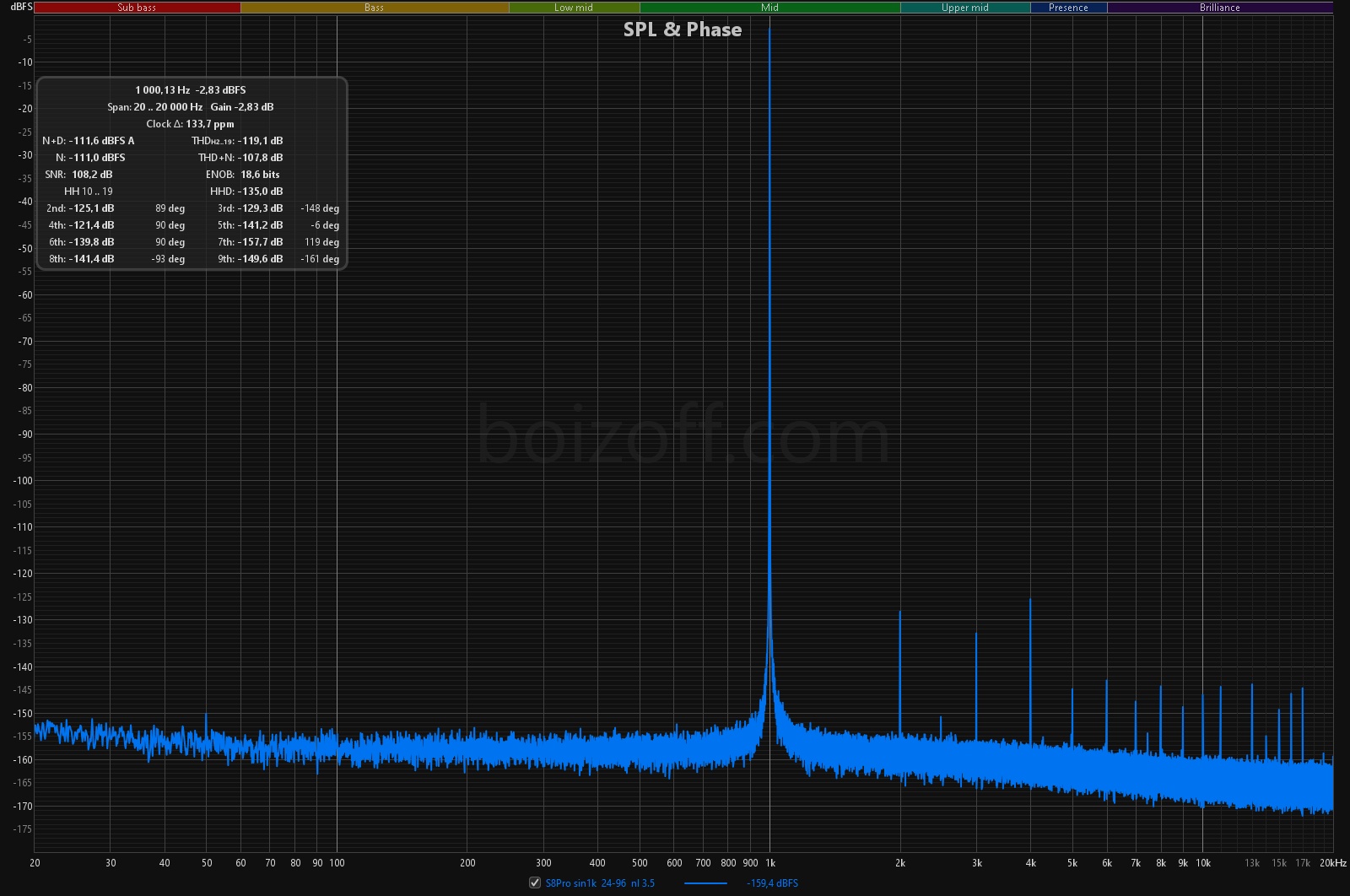
| Parameter | Value |
| Noize+Distortion | -111.6 dBFS |
| Noize | -111.0 dBFS |
| SNR | 108.2 dB |
| THD | -119.1 dB |
Sine at 1 kHz (0 dBFS), 100% volume on S8 Pro, 4.4 output, no load:
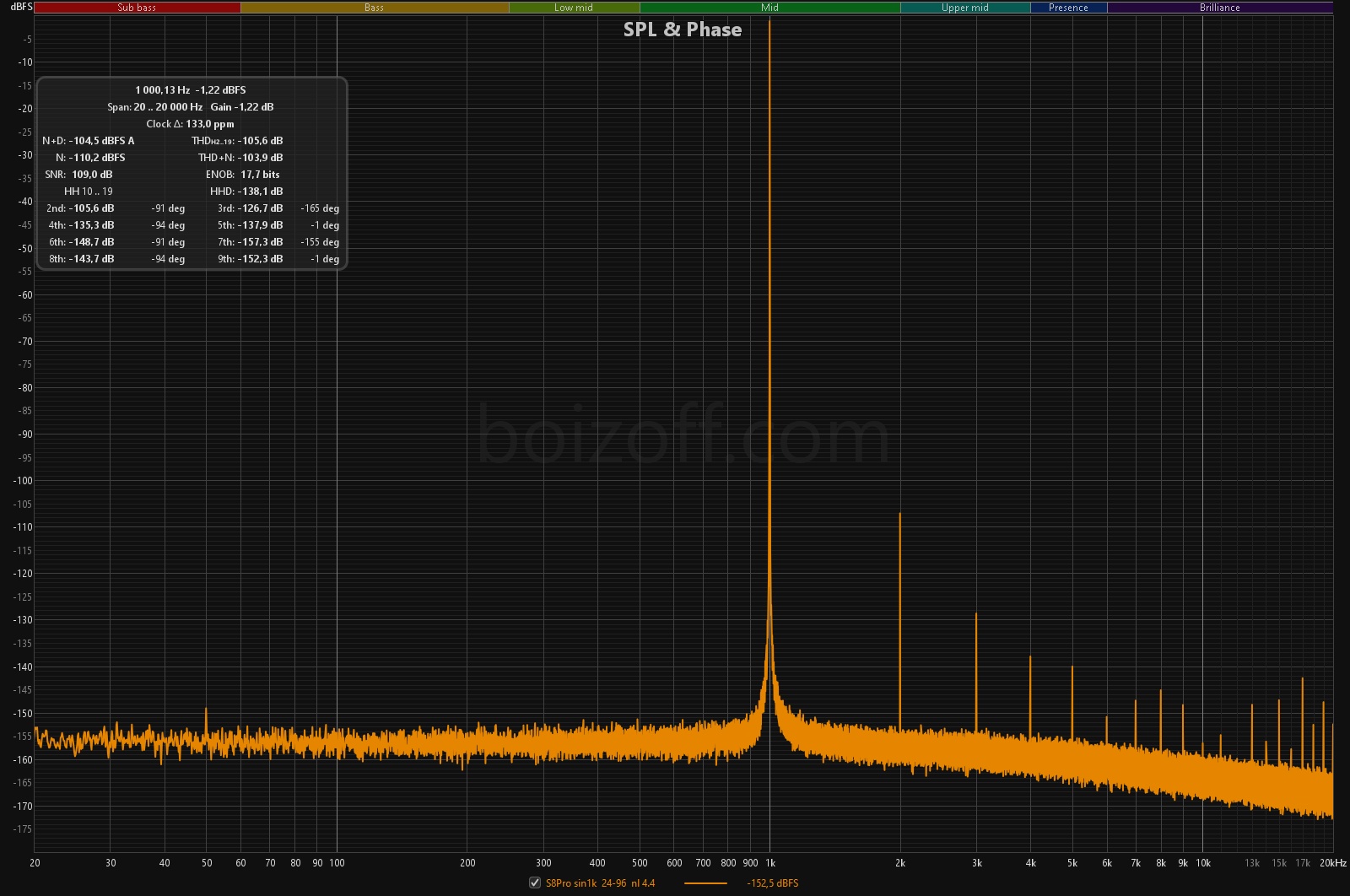
| Parameter | Value |
| Noize+Distortion | -104.5 dBFS |
| Noize | -110.2 dBFS |
| SNR | 102.2 dB |
| THD | -115.6 dB |
It’s clear that no-load measurements don’t allow for analyzing DAC quality in actual use. Due to this, I did as follows:
- In the morning, with my head and ears fresh, I listened to several albums on S8 Pro at my routine volume to really listen to music in the morning — i.e., loud. Then, using a calibrated microphone, I measured this volume level (sine at 1 kHz). It turned out to be 93 dB.
- To achieve this volume level on S8 Pro, you need to set: 54% volume for Truthear x Crinacle ZERO: RED earphones used at the unbalanced output; the same 54% volume for Meze Empyrean headphones used at the balanced output.
And now let’s take measurements at the above volume levels with the above headphones.
Sine at 1 kHz (0 dBFS), 54% volume on S8 Pro, 3.5 output, Truthear x Crinacle ZERO: RED as load:
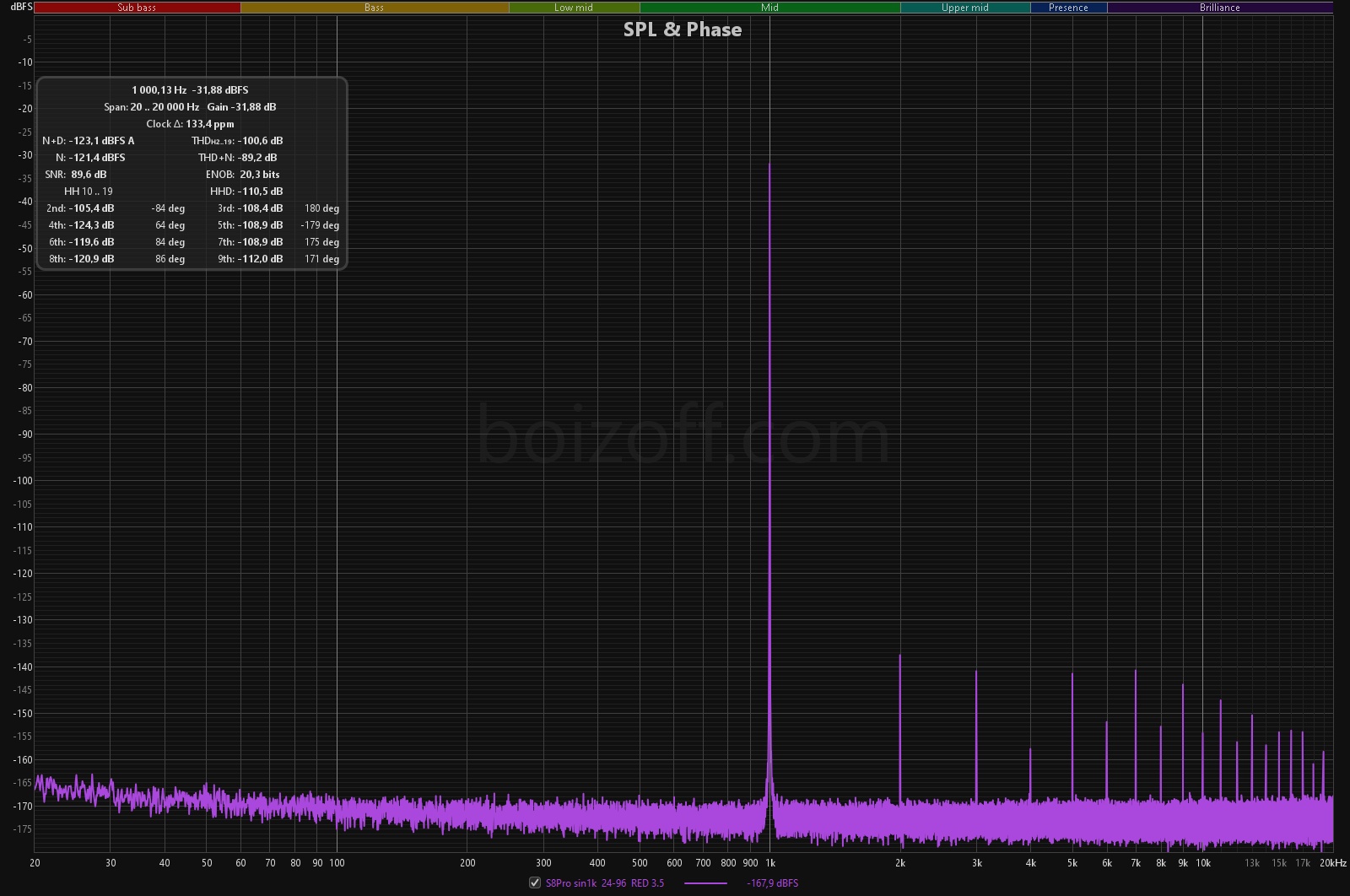
| Parameter | Value |
| Noize+Distortion | -123.1 dBFS |
| Noize | -121.4 dBFS |
| SNR | 89.6 dB |
| THD | -100.6 dB |
Sine at 1 kHz (0 dBFS), 54% volume on S8 Pro, 4.4 output, Meze Empyrean as load:
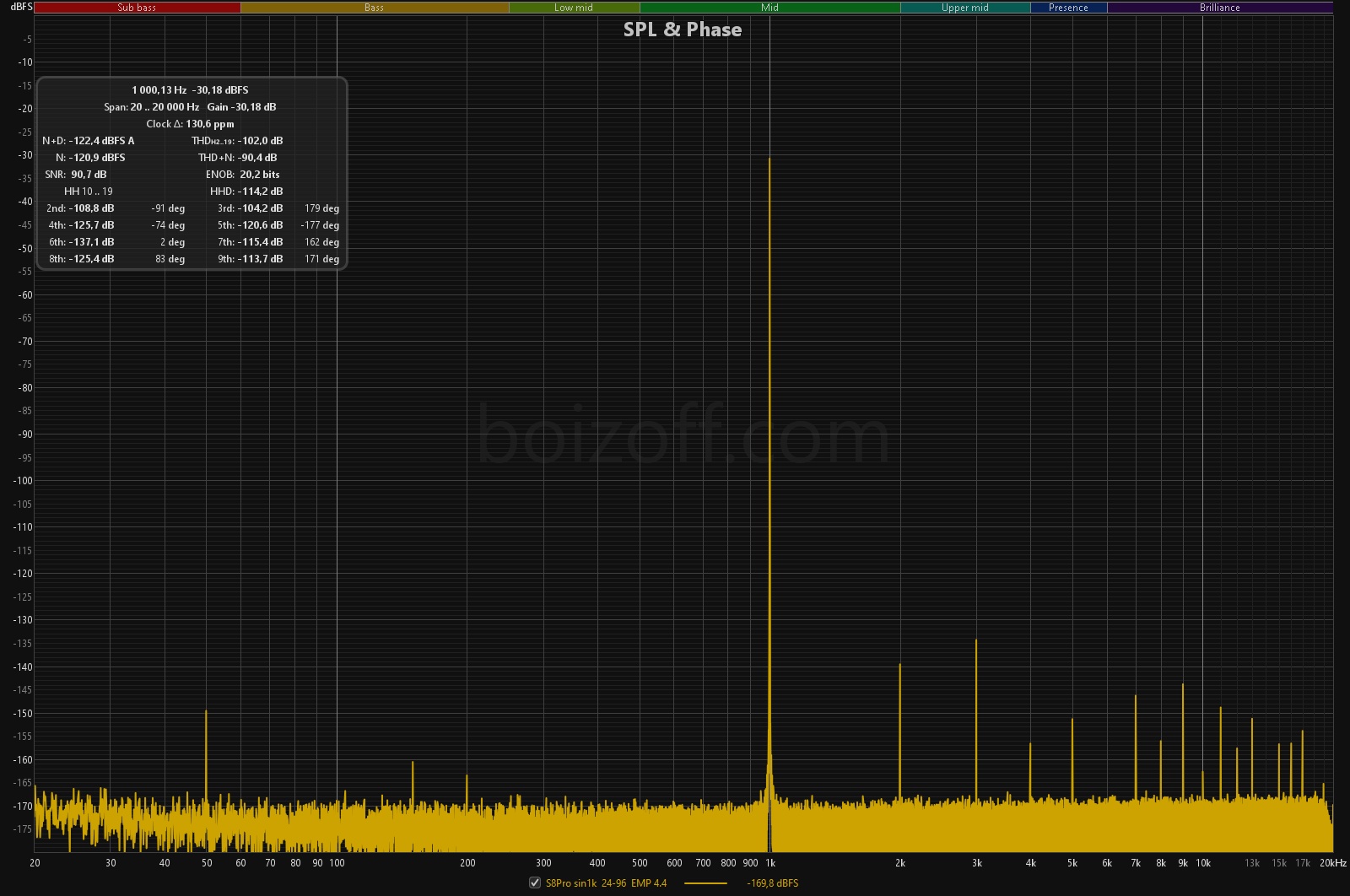
| Parameter | Value |
| Noize+Distortion | -122.4 dBFS |
| Noize | -120.9 dBFS |
| SNR | 90.7 dB |
| THD | -102.0 dB |
S8 Pro vs. DAWN Pro
A clear choice of a device for comparison is MoonDrop DAWN Pro: a similar price, some $56 for DAWN Pro versus some $79 for S8 Pro, similar characteristics and dimensions.
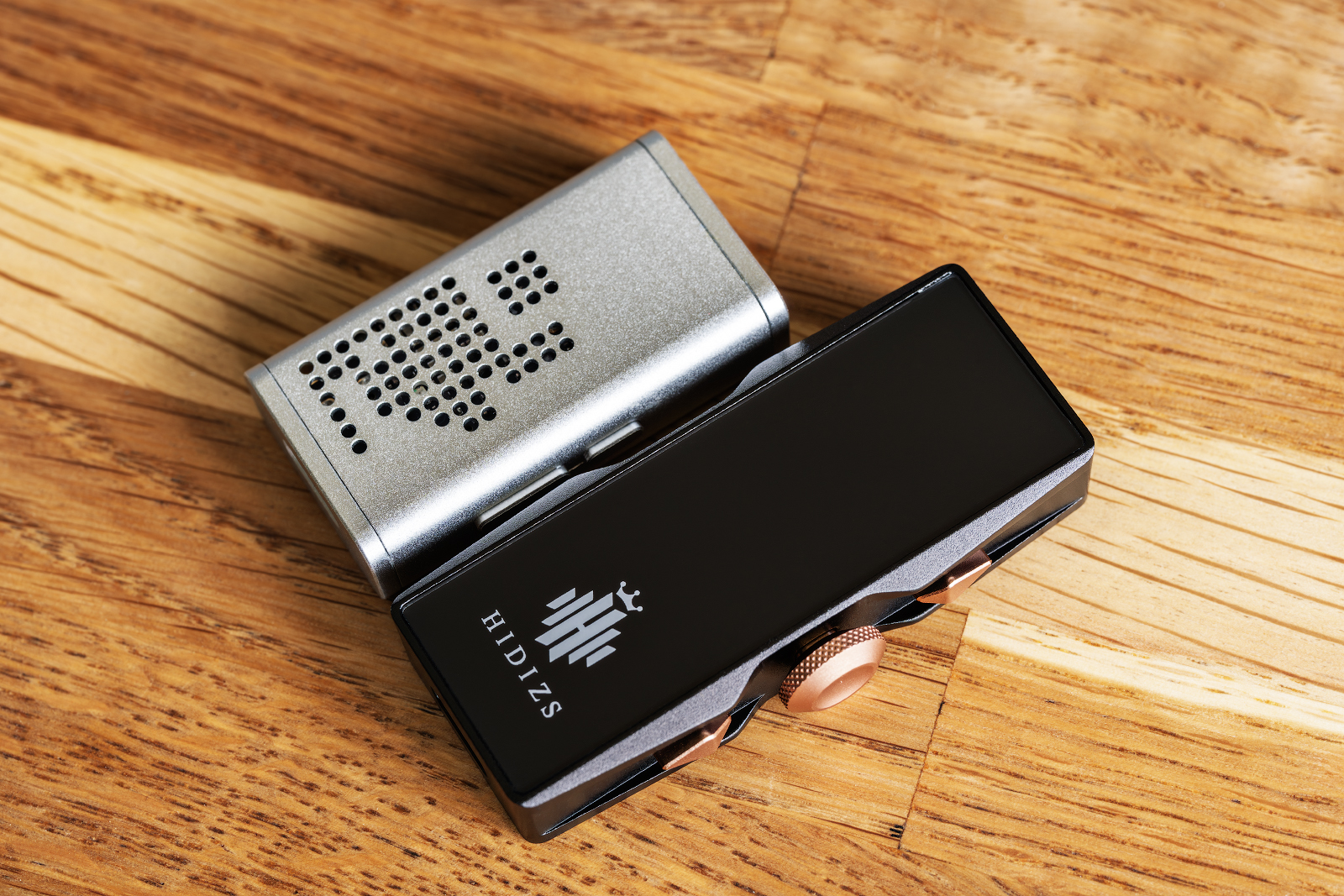
Noticeable differences between them:
- S8 Pro is a bit longer;
- DAWN Pro buttons clatter like a ton of bricks, while S8 Pro ones don’t;
- S8 Pro buttons are much easier to grope blind than Dawn Pro ones;
- S8 Pro doesn’t have gain level switch;
- S8 Pro buttons are stuck to software volume, while Dawn Pro ones control the amplifier’s own volume and the slider on Windows/Android lives its own independent life. And this is totally uncomfortable: to look at a particular volume value of DAWN Pro, you need to reach into the mobile app.
Sine at 1 kHz (0 dBFS), DAWN Pro, 3.5 output, Truthear x Crinacle ZERO: RED as load, 94 dB output volume:
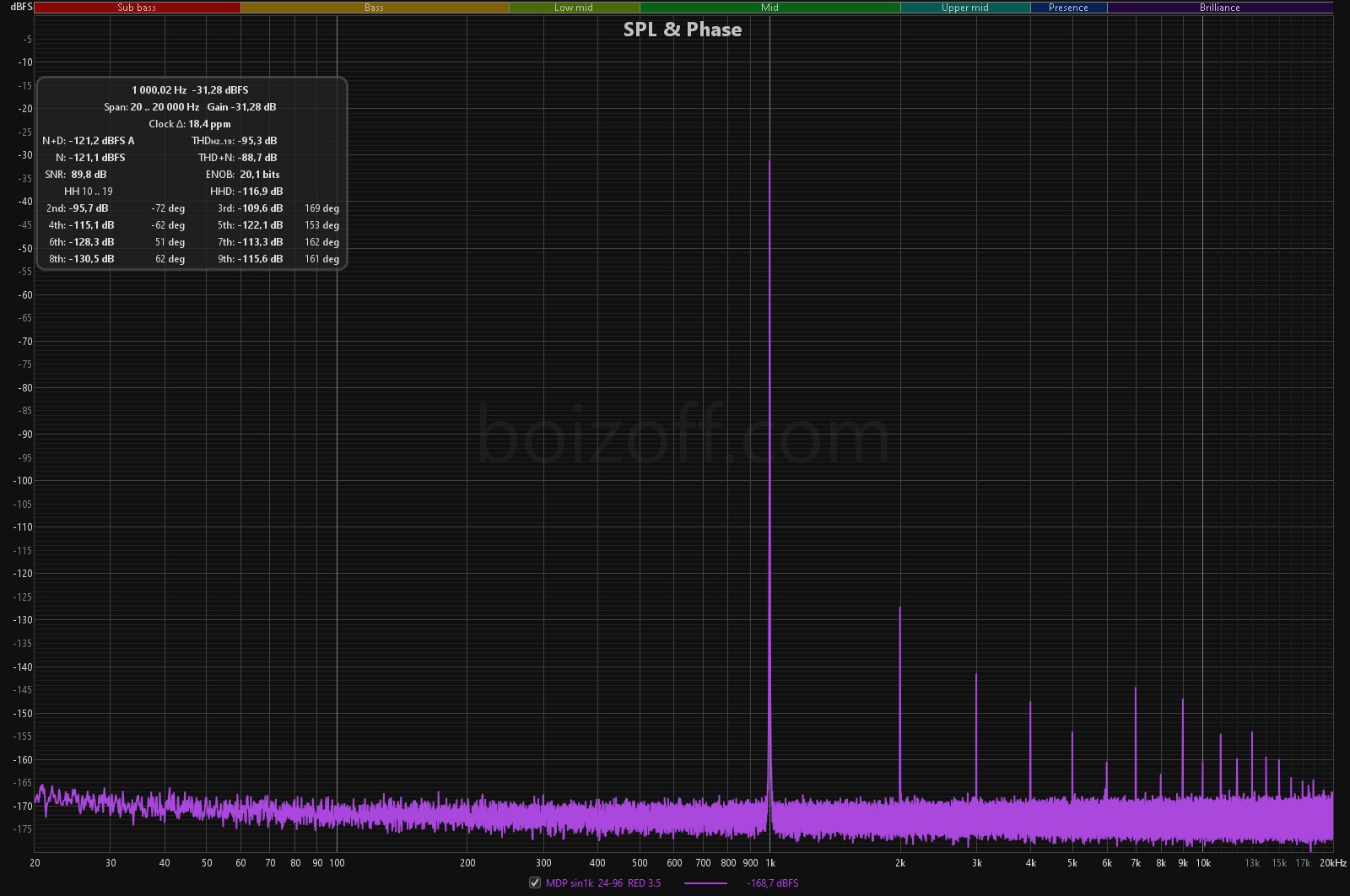
Sine at 1 kHz (0 dBFS), DAWN Pro, 4.4 output, Meze Empyrean as load, 94 dB output volume:
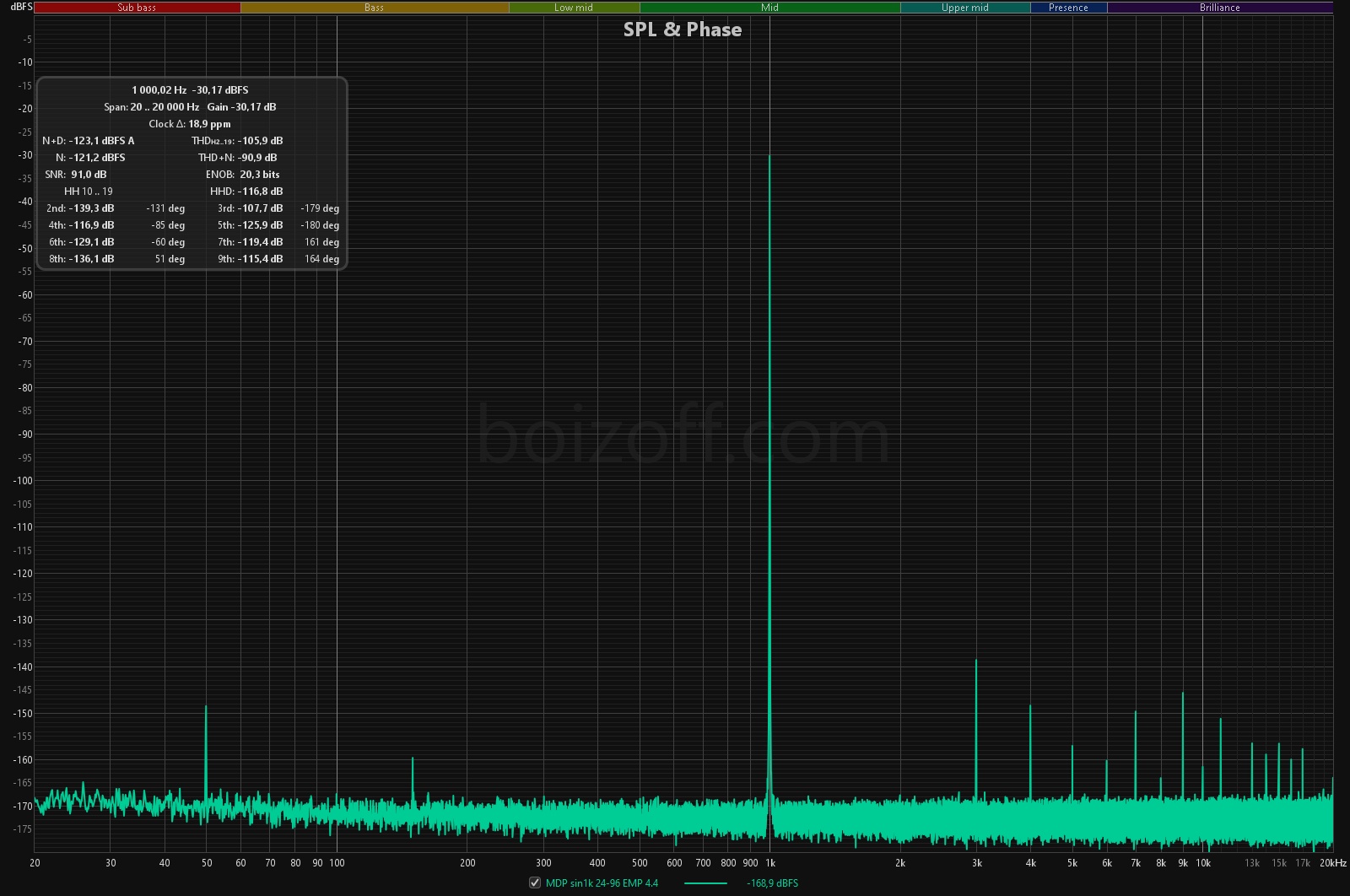
Measurement and comparison results for 3.5 (Truthear x Crinacle ZERO: RED as load, 94 dB output volume):
| Parameter | S8 Pro, 3.5 Value | DAWN Pro, 3.5 Value |
| Noize + distortion | -123.1 dBFS | -121.2 dBFS |
| Noize | -121.4 dBFS | -121.1 dBFS |
| SNR | 89.6 dB | 89.8 dB |
| THD | -100.6 dB | -95 dB |
Measurement and comparison results for 4.4 (Meze Empyrean as load, 94 dB output volume):
| Parameter | S8 Pro, 4.4 Value | DAWN Pro, 4.4 Value |
| Noize + distortion | -122.4 dBFS | -123.1 dBFS |
| Noize | -120.9 dBFS | -121.2 dBFS |
| SNR | 90.7 dB | 91.0 dB |
| THD | -102.0 dB | -105.9 dB |
That is to say, by and large, the numbers are the same.
Subjective listening experience
For listening test, the device was connected to a PC via the Topping HS01 isolator.
Sources used (3.5 outputs):
- Hidizs S8 Pro;
- MoonDrop DAWN Pro;
- RME ADI-2 DAC (IEM output);
- Hiby R6 Pro III.
Headphones used:
- Truthear x Crinacle ZERO: RED
- Truthear HEXA;
- Binary Acoustics Chopin;
- MoonDrop PARA;
- Meze Empyrean;
- Focal Utopia.
Musical content used:
- Cellar Darling – The Spell (2019) (flac 24/48);
- BADBADNOTGOOD – III (2014) (flac 16/44);
- V.A. — Dr. Chesky’s Sensational, Fantastic, and Simply Amazing Binaural Sound Show (2012) (flac 24/96);
- Trigg Gusset – The Way In (2020) (flac 16/44);
- Rameau — The Sound of Light (Teodor Currentzis) (flac 16/44);
- Parov Stellar — The Demon Diaries (2015) (flac 24/44);
- Ozzy Osbourne – Dreamer (2014) (flac 16/44);
- Neotropic — 15 Levels Of Magnification (1996) (flac 16/44);
- Kaleida – Odyssey (2020) (flac 16/44);
- John Coltrane — Blue Train (2012 remastered) (flac 24/192);
- Prodigy — The Day Is My Enemy (2015) (mp3 256);
- Portishead – Third (2008) (flac 16/44);
- Michel Camilo and Tomatito — Spain Forever (2016) (flac 24/96).
To compare the sound with other sources, a paired comparison was performed using a mechanical input switch with near-zero impedance; the volumes of all sources (with certain headphones) were previously aligned at 87 dB on the measuring rig; switching was carried out with the help of an external person, and I could not see which source was selected; comparative listening was carried out in the morning, with my ears ‘fresh’, in absolute silence.
- S8 Pro vs. DAWN Pro: DAWN Pro provides just a very tiny little bit more significant impact at subbass. It’s barely audible on those tracks where it’s well separated from other sounds, such as Parov Stellar – Demon Dance. Plus, it’s heard only with Focal Utopia, not with other headphones.
- S8 Pro vs. ADI-2 DAC: S8 Pro seems to sound a little sharper, a little more pronounced at high frequencies. But, most likely, it just felt this way.
- S8 Pro vs. Hiby R6 Pro III: I didn’t hear any difference.
The differences between the sources are… little to nothing. Barely perceptible. Almost indistinguishable. Minute.
In the big scheme of things, it makes no difference.
S8 Pro just provides a good sound. A decent, clear, full-fledged sound.
Summary
Hidizs managed to produce an excellent competitive product. S8 Pro sounds good, is user-friendly and nice in terms of design. The manufacturer wants adequate money for it in the current market.
The problem is that I can write it… about almost any modern portable DAC at a similar cost. I can’t say that S8 Pro is mediocre, this problem is of another kind – all such devices are functionally identical or next to identical, and their sound quality has gone beyond all reasonable user stories long ago. In its next version, it would be cool to see some features that would distinguish the device from its competitors:
- an N-band or even a parametric equalizer, the ability to work with presets;
- active noise reduction using microphones on the body;
- AI-based noise reduction of clicks on digitized vinyls;
- a handy-dandy ADC so that the device could efficiently work with wired headsets.
Hold my beer, as we say, and I’ll come up with a dozen more.
In short, I’d want a cherry on top for the same money — or further cost reduction with no characteristics or functions degraded.
But even without that cherry, S8 Pro is an excellent powerful DAC that can get going, like, virtually any headphones in terms of balance (probably, not Modhouse Tungsten). It’s technical, precise, and fitted with a NOS filter. To buy or not to buy: consider your personal usage scenario, and yes, if it works for you, go right ahead.
